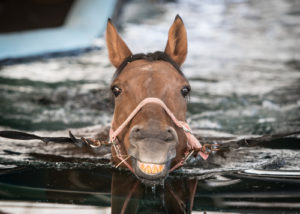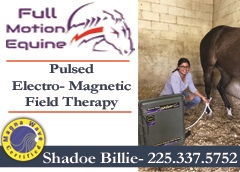By Neely Walker, PhD.
Physiological conditioning is one of the key factors in obtaining peak performance in horses. Ensuring your horse is conditioned prior to competition is important to reduce the chance of injury and increase your opportunity for success. Basic conditioning principles require addressing multiple physical systems including: the respiratory system, the cardiovascular system, muscular anatomy, and fitness of tendons, ligaments, and bone. Typical conditioning protocols that address these physical systems include 3-4 months of slow, long distance work, followed by an additional 1-2 months of speed and skill training, depending upon discipline. Traditional methods of conditioning include mechanical walkers, treadmills, and riding programs. However, underwater treadmills and swimming programs have recently become more affordable and available to the equine community.
Underwater or partially submerged treadmills combine the buoyancy of a swimming pool and the mechanical advantage of a treadmill. There are two types of underwater treadmills available; in ground units; which require the horse to walk into a treadmill that is already submerged, and an above ground unit; which a horse is walked into a fiberglass tank that contains a treadmill and then the water is added. Both types of submerged treadmills are used primarily in rehabilitation conditioning. The benefit of an underwater treadmill is the water increases the buoyancy of the animal, reducing the amount of stress placed on the legs and back by up to 45%. Research has shown that horses exercised on an underwater treadmill have an increased stride length and decreased stride frequency suggesting that the water increases resistance and provides an effective method to increase cardiovascular, respiratory, muscle, and tendon conditioning. While underwater treadmills are appropriate for horses returning to conditioning following an injury, limitations in the variability in speed and slope of the treadmill prevent underwater treadmills in being effective at conditioning horses without injury.
Swimming is an excellent conditioning activity that allows a horse to exercise in a completely buoyant environment reducing the weight bearing activity. Swimming has been part of conditioning programs since the early 70’s. Recent research has indicated that swimming horses for 5-8 minutes can increase a horse’s heart rate from 34 beats per minute to 175 beats per minute; similar to the 200 beats per minute experienced by breezing a horse on the racetrack. It is estimated that swimming a horse for 15 minutes is similar to hand-galloping a horse for 5 miles. While swimming is a great conditioning technique for fitness and rehabilitation, it is not recommended for horses with back or rear limb injuries. Horses must arch their neck to breath while swimming, which in turn hollows their back out and compresses their spine. Horses also must rely heavily on their rear legs to propel them through the water, which can potentially worsen any lameness issue.
Advances in technology continue to offer unique opportunities to assist in conditioning horses during the rehabilitation and performance phases of their career. No one exercise is adequate to replace a traditional well planned conditioning program, however, underwater treadmills and swimming are two additional ways to reach the level of physiological fitness and conditioning needed to increase your chances for success in the show pen.
References:
- Nankervis, K.J. & R. J. Williams. 2006. Heart rate responses during acclimation of horses to water treadmill exercise. Equine Exercise Physiology 7:36(2006) pgs 110-112.
- Scott, R., Nankervis, K., Stringer, C., Westcott, K. & D. Marlin. The effect of water height on stride frequency, stride length and heart rate during water treadmill exercise. Equine Vet. J. 42:662-664
- Adair, H.S. 2011. Aquatic Therapy for Conditioning and Treatment of Tendon and Ligament Injuries. 2011 AAEP Annual Convention Presentation.
Photo: Copyright: <a href=’https://www.123rf.com/profile_epstock’>epstock / 123RF Stock Photo</a>









